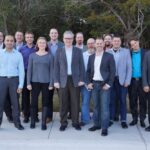|
|
This Presentation date is January 16, 2015 at 08:00 - 12:00.
Presenters: Carol Pflueger, John Maxwell, John Shirley, Kishore Gagrani, Matt Baker, Mervin Nalletamby, Scott DesBles
Dell Enterprise Strategy Review
Watch on YouTube
Watch on Vimeo
Matt Baker, Executive Director of Enterprise Strategy, introduces Dell at Virtualization Field Day 4. He discusses the Dell approach to IT products and services in the enterprise and the status of the newly-private company.
Personnel: Matt Baker
Dell Foglight for Virtualization
Watch on YouTube
Watch on Vimeo
John Maxwell, VP PM, and Kiran Ranabhor, Sr. PM, introduce Dell Foglight for virtualization.
Personnel: John Maxwell, Kiran Ranabhor
Dell Foglight Demo
Watch on YouTube
Watch on Vimeo
Kiran Ranabhor, Sr. PM, demonstrates Dell Foglight for virtualization and takes questions from the Tech Field Day delegates.
Personnel: Kiran Ranabhor
Redefining the Economics of Enterprise Storage with Dell
Watch on YouTube
Watch on Vimeo
Scott DesBles, Storage Product Manager, discusses the history and future of enterprise storage at Dell. He begins with a review of the company’s acquisitions and discusses how they have been integrated into the Dell product line. He then covers the Dell storage portfolio and Dell’s position on software-defined storage.
Personnel: Scott DesBles
Dell Supercharging Storage with NVMe and Fluid Cache
Watch on YouTube
Watch on Vimeo
Kishore Gagrani, Global Product Director, PowerEdge Caching, presents Dell’s NVMe solution, Fluid Cache.
Personnel: Kishore Gagrani
Dell Flash Storage Strategy and Outlook
Watch on YouTube
Watch on Vimeo
John Shirley, Sr. Manager, Planning & Strategy, outlines Dell’s flash storage strategy and outlook.
Personnel: John Shirley
Unleashing the Data Services Economy with Intel
Watch on YouTube
Watch on Vimeo
Mervin Nalletamby, Field Engineer for Intel, presents the company’s vision of a data services economy. He presents the rise of a digital service economy and how Intel-based servers like Dell PowerEdge are disrupting the data center with software-defined infrastructure.
Personnel: Mervin Nalletamby
Dell PowerEdge FX Architecture
Watch on YouTube
Watch on Vimeo
Carol Pflueger, Servers Product Manager at Dell, introduced the Dell PowerEdge FX architecture, which integrates Dell’s networking, servers, and storage into a modular 2U chassis. The FX architecture, where FX stands for flexible, aims to maximize workloads, simplify operations, and enhance efficiency. The FX2 chassis, a key component, can house various compute and storage nodes, such as the FC630, FM120, FC430, FD332, FC830, and IOAggregator. Pflueger emphasized that Dell is not moving away from traditional racks, blades, or towers but is instead enhancing functionality by merging the best features of these systems into the FX architecture.
The FX2 chassis is designed to be highly flexible, allowing for different configurations of compute and storage nodes. For instance, the FC630 compute node is essentially a blade server adapted to fit into the FX2 chassis. The FD332 storage node can be paired with compute nodes to provide direct-attached storage, with flexible PCIe mapping allowing compute nodes to own specific storage nodes and PCI slots. This modular approach enables various configurations, such as having two FC630s and two FD332s in a single chassis, with each compute node owning half of the storage node’s drives. The architecture also supports advanced management through Dell’s CMC (Chassis Management Controller), which can manage the FX2 as either a standard rack or a blade system.
The FX architecture also includes innovative features like the FM120 microserver, which houses multiple low-power Avoton processors, making it suitable for hosting and caching applications. The FC430, another compute node, offers high density with up to eight nodes in a 2U chassis, each supporting E5-2600 V3 processors and up to eight DIMMs. The architecture’s flexibility extends to networking, with options for 1 gig, 10 gig, and future 40 gig connections, as well as the ability to bypass the PCI switch for low-latency applications using InfiniBand. The FX2 chassis also supports advanced cooling and power management, with options for 1100W, 1600W, and upcoming 2000W power supplies, ensuring efficient operation even in dense configurations.
Personnel: Carol Pflueger









